Every contractor knows the pressure of bid deadlines: the clock ticking, spreadsheets open, and the risk of a single formula error throwing everything off. It’s a process that too often eats up days. But with today’s technology, it doesn’t have to.
The difference is both speed and its survival in a market where winning often comes down to who can submit first with confidence. Manual methods drain time, introduce errors, and leave bids vulnerable to outdated pricing.
This is where construction estimating software changes the game. From automated takeoffs to real-time pricing and pre-built templates, it reduces bid preparation time by half while improving accuracy.
Today, we’ll explore how modern platforms like ConstructionBase are helping contractors win more work, with less stress.
Construction Estimating Software for Accurate, Clear Estimates and Cost Analysis
Accurate estimates are the backbone of winning bids and profitable projects. These estimates are what separate thriving construction companies from those constantly playing catch-up.
With modern construction estimating software, businesses can move beyond manual data entry and spreadsheets to create comprehensive estimates more quickly and with fewer errors.
From construction cost estimating and real-time cost tracking to material and labor costs, advanced reporting, and collaboration tools, these estimating solutions streamline complex projects, improve project management, and empower construction companies with clear estimates and data-driven decisions.
Key Takeaways
- Estimating software cuts bid prep time by up to 50–80%, boosting efficiency and win rates.
- Real-time pricing and automated takeoffs ensure error-free, competitive construction bids.
- Cloud-based collaboration simplifies teamwork, reviews, and project coordination.
- Tools like ConstructionBase make estimating faster, smarter, and more profitable for contractors.
Manual Estimating: Hidden Pain Points
For decades, construction businesses have relied on manual estimating methods, including spreadsheets, calculators, and extensive manual data entry. A familiar, this approach creates more problems than solutions.
A McKinsey study found that construction projects typically run 80% over budget and 20 months behind schedule, with inaccurate cost estimating as one of the root causes. Even seasoned estimating professionals find it nearly impossible to consistently deliver accurate estimates using outdated tools.
| Pain Point | Impact on Construction Companies |
|---|---|
| Slow, manual takeoffs | Preparing a complete estimate takes days instead of hours, delaying bid submissions and losing opportunities. |
| Human error in spreadsheets | Miscalculations in construction cost estimating can erode profits and increase project risk. |
| Outdated pricing | Using old rate cards leads to inaccurate cost analysis, poor job costing, and unreliable construction cost forecasts. |
| Lack of collaboration | Teams work in silos, slowing reviews, project management approvals, and construction management needs. |
| Inflexibility | Adjusting bids for design or material changes is a time-consuming and error-prone process. |
In today’s construction industry, average profit margins are approximately 6% (Autodesk). So, every error matters, and manual processes can’t keep up with the pace of modern construction projects.
Estimating software replaces inefficiencies with user-friendly estimating templates, real-time cost tracking, and data-driven decisions, helping construction companies save time, deliver detailed estimates, and submit professional proposals without the steep learning curve.
Explore the 5 Common Construction Estimating Mistakes (and How Software Fixes Them)
Why Speed and Accuracy Matter in Construction Bidding
In construction projects, every hour spent juggling spreadsheets or rechecking figures can mean losing the bid to a faster competitor. For construction businesses, the time difference often determines whether they secure a lucrative contract or miss out.
This means speed and accuracy work hand in hand. Quick estimates allow contractors to respond to bid opportunities before deadlines close, while precision ensures the numbers hold up once the project begins.
Even a small miscalculation in material or labor costs can lead to budget overruns, delayed timelines, and strained client relationships.
In short, faster and more precise estimating tools don’t just save time; they increase win rates, strengthen customer relationship management, and unlock new growth opportunities for construction businesses.
Check out Automated Bidding: Speeding Up Estimate Turnaround.
How Construction Estimating Software Changes the Game
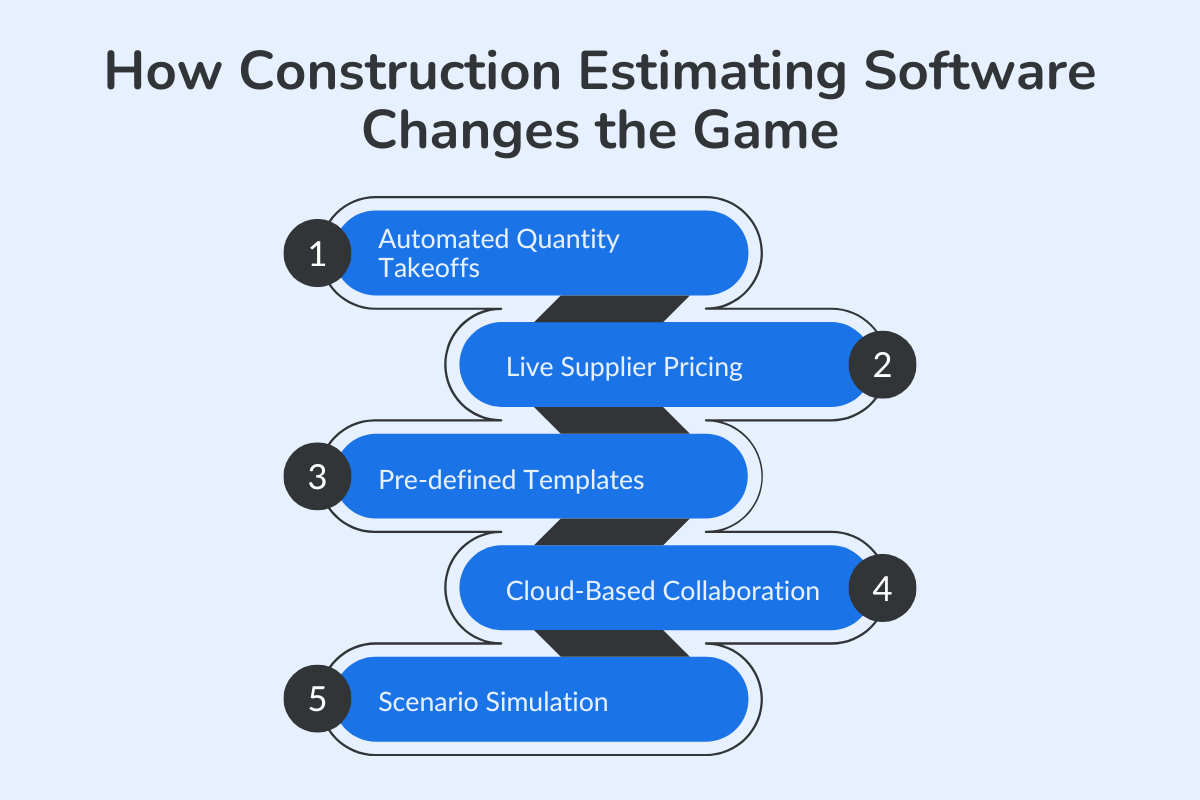
Construction estimating software is transforming the bid process across the construction industry. Instead of wasting days on manual data entry and disconnected spreadsheets, contractors can now generate detailed estimates in a fraction of the time.
Key features driving this shift include:
- Automated Quantity Takeoffs: Digital and floor plans extract material and labor costs instantly, eliminating human error.
- Live Supplier Pricing: Real-time material pricing ensures competitive pricing and a dynamic cost database for every estimate.
- Pre-defined Templates: User-friendly estimating templates and custom assemblies speed up estimating for complex projects.
- Cloud-Based Collaboration: Multiple estimators can work together simultaneously, streamlining reviews, job costing, and approvals.
- Scenario Simulation: Quickly test “what-if” scenarios on design or material changes without restarting the estimation process.
Beyond automation, advanced reporting, seamless integration with accounting software, and error-free estimating, this creates an all-in-one solution for both small construction businesses and large enterprises. The result? Clear estimates, competitive bid packages, and smarter, data-driven decisions.
With bid prep time cut in half, construction companies can submit more proposals, improve team efficiency, and boost long-term profitability.
Comparison Of Top Construction Estimating Software
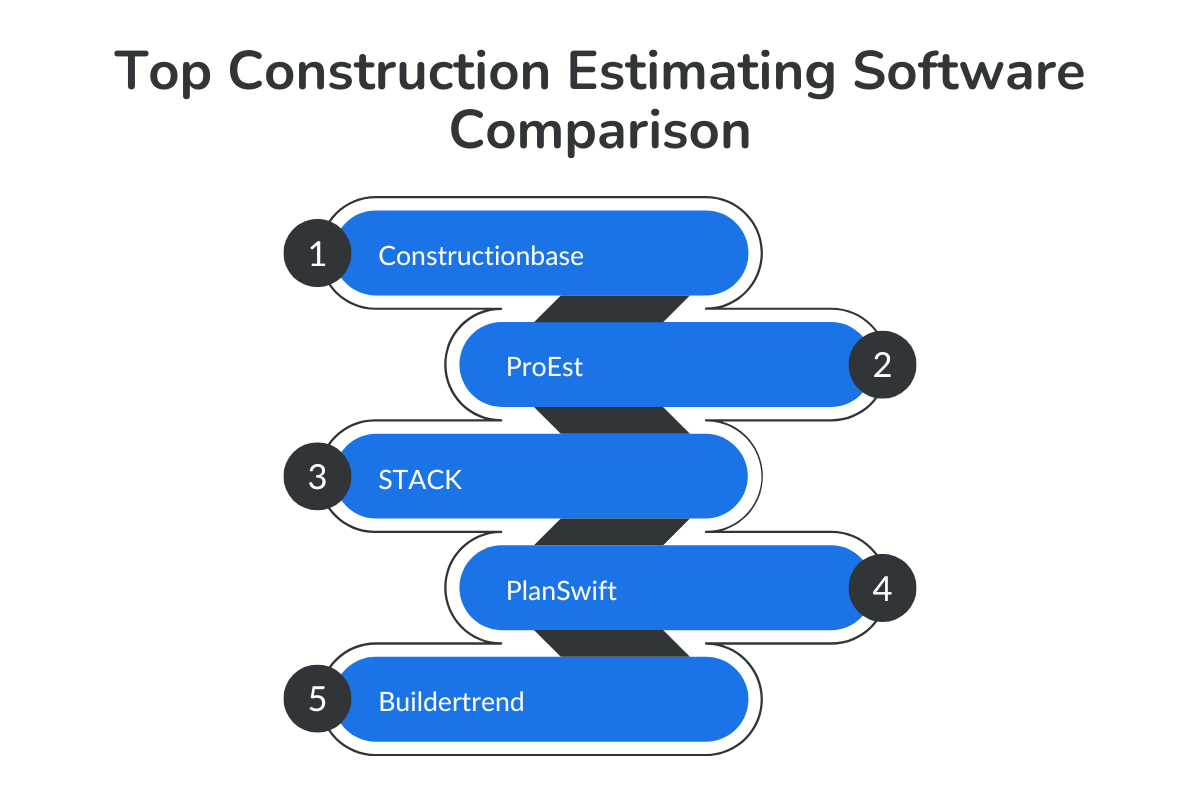
1. ConstructionBase
- Automated Quantity Takeoffs: Instantly extract material quantities from digital blueprints, reducing manual entry and errors.
- Smart Cost Estimation Engine: Automatically calculate total project costs by combining materials, labor, equipment, and overheads — giving estimators a clear, real-time breakdown before bid submission.
- Live Supplier Pricing Integration: Access up-to-date material costs to ensure accurate and competitive bids.
- Cloud-Based Collaboration: Enable real-time teamwork among estimators, enhancing efficiency and communication.
- Template-Based Estimates: Use pre-built templates for different project types (residential, commercial, or infrastructure) to speed up estimate creation and maintain consistency across teams.
- Integrated Proposal Generation: Convert approved estimates into detailed, client-ready proposals with branded templates and digital signatures to accelerate approvals.
- Data-Driven Analytics & Reporting: Access dashboards showing bid success rates, cost trends, and profit margins to refine pricing strategies and improve future estimates.
Pricing: Custom pricing based on company size and project volume. Free demo and trial available on request.
2. ProEst
- Digital Takeoffs: Perform takeoffs directly from digital plans, streamlining the estimation process.
- Comprehensive Cost Database: Utilize an extensive database for accurate material and labor cost estimation.
- Bid Day Analysis: Analyze bids on the day of submission to ensure competitiveness and profitability.
- Cloud-Based Access: Access estimates anytime, anywhere with ProEst’s secure cloud platform, allowing teams to collaborate and edit bids in real time.
- Automated Estimate Templates: Use customizable templates to quickly build consistent estimates for different project types, reducing setup time and human error.
Pricing: Available through custom quotes based on user needs and project scale. Typically starts around $5,000 annually with cloud hosting and support included.
3. STACK
- Cloud-Based Takeoff: Upload and measure digital plans in the cloud, facilitating remote access and collaboration.
- Customizable Templates: Use pre-built templates to standardize and expedite the estimating process.
- Real-Time Collaboration: Work simultaneously with team members to improve efficiency and accuracy.
- Bid Management Integration: Connect takeoffs and estimates directly to bid submissions, improving accuracy and helping contractors stay competitive on bid day.
- Customized Estimating: Combine takeoffs with live material and labor cost data to instantly generate detailed and accurate project estimates.
- Dynamic Reporting & Analytics: Visualize cost breakdowns, material usage, and project summaries with interactive dashboards that support smarter decision-making.
Pricing: STACK offers a free version with limited features. Custom pricing is available for enterprise teams.
4. PlanSwift
- Drag-and-Drop Takeoff: Easily measure areas, lengths, and counts with intuitive tools.
- Custom Formulas: Create custom assemblies and formulas to tailor estimates to specific needs.
- Excel Integration: Import and export data seamlessly with Excel for enhanced flexibility.
- Real-Time Cost Calculations: Automatically calculate material, labor, and equipment costs as you perform takeoffs—keeping estimates accurate and up to date.
- Digital Plan Management: Store, organize, and navigate multiple blueprints within one workspace, making it easy to manage revisions and compare drawings.
- Custom Reporting: Generate detailed cost breakdowns, summaries, and bid reports that can be shared directly with clients or internal teams.
- Integration with Accounting and Bidding Tools: Connect PlanSwift data with popular construction management and accounting software to create a seamless flow from takeoff to bid submission.
Pricing: PlanSwift offers a free trial for new users. The one-time license purchase starts at around $2,000 per user.
5. Buildertrend
- Integrated Estimating Tools: Combine estimating with project management and scheduling features.
- Client Communication: Facilitate client interactions through built-in messaging and portals.
- Financial Management: Manage budgets, change orders, and invoices within the platform.
- Prebuilt Estimate Templates:
Use customizable templates for faster bid creation and consistent, professional estimates across all projects. - Real-Time Cost Tracking: Monitor material and labor costs as projects progress to maintain profitability and prevent budget overruns.
- Bid Request Management: Send, receive, and compare subcontractor bids directly within Buildertrend, ensuring competitive and accurate pricing.
- Integration with Accounting Software: Sync seamlessly with QuickBooks and Xero to ensure financial accuracy and eliminate manual data entry.
- Custom Proposal Generation: Turn estimates into branded client proposals complete with pricing, inclusions, and digital approval options.
Pricing: Buildertrend offers pricing on request. The prices depend on team size and feature access
Beyond Numbers: Collaboration, Transparency, and Flexibility
Estimating software isn’t just about faster cost analysis; it’s about transforming how construction businesses work together.
Instead of fragmented communication and siloed spreadsheets, multiple estimators and subcontractors can collaborate in real-time using cloud-based access and collaboration tools.
Transparency also matters. By tracking labor hours, material costs, and other cost elements openly, contractors can build trust with both clients and internal teams.
Add flexible scenario simulations, and estimating professionals can instantly model design or material changes without having to start over a lifesaver for complex projects.
The outcome? Accurate estimates, fewer technical difficulties, and stronger customer relationship management. For construction companies juggling multiple bids, this transparency and flexibility improve both team efficiency and long-term client satisfaction.
ROI: Why Estimating Software Pays for Itself
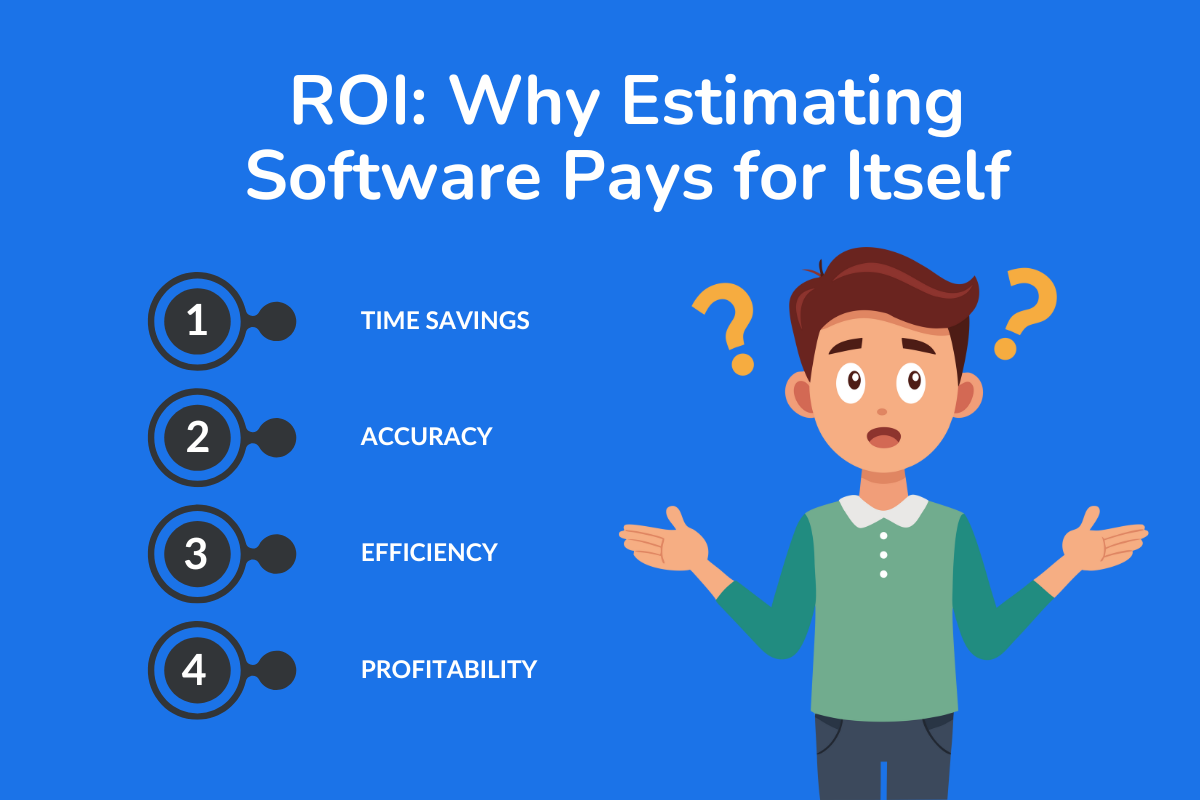
Adopting modern construction cost-estimating software delivers a measurable ROI. The numbers tell a powerful story:
- Time savings: A manual bid takes around 20 hours, while software reduces this to just 4 hours, an 80% reduction.
- Accuracy: Error-free estimating lowers the risk of costly overruns, ensuring a complete estimate every time.
- Efficiency: Multiple estimators can work simultaneously, streamlining bid package approvals.
- Profitability: Faster, more accurate estimates improve win rates, enabling construction businesses to scale effectively.
For construction companies, the payback is clear: estimating software not only saves time but also safeguards profitability.
Manual vs. Software: A Clear Side-by-Side Comparison
Finally, let’s put manual estimating head-to-head with modern estimating software.
| Metric | Manual Estimating | With Software |
|---|---|---|
| Average Bid Prep Time | 20 hours | 4 hours |
| Errors/Corrections Needed | High | Minimal |
| Team Collaboration | Fragmented | Real-time, Cloud-based |
| Financial Accuracy | Medium | High |
| Scenario Analysis | Difficult | Automated simulations |
| Reporting | Manual spreadsheets | Dashboards & advanced reporting |
| Scalability | Limited | Flexible, grows with construction management needs |
| Pricing Data | Stale rate cards | Live supplier pricing |
The difference is undeniable: while manual methods hinder growth, construction estimating software enables businesses to create detailed estimates quickly, maintain competitive pricing, and streamline the entire bid process.
Choosing the Best Construction Estimating Software
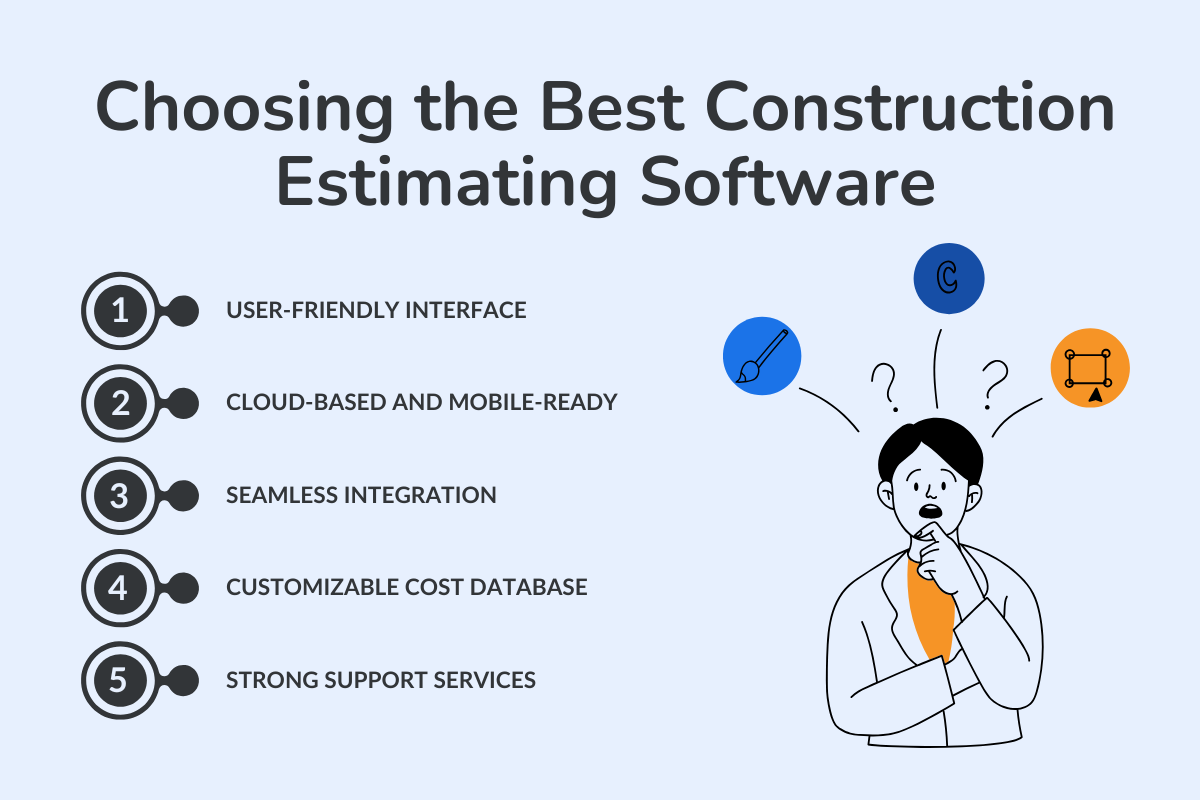
Not all software solutions are created equal. Contractors need to prioritize tools that strike a balance between speed, accuracy, and usability without introducing a steep learning curve. Here’s a quick checklist:
- User-friendly interface with intuitive workflows.
- Cloud-based and mobile-ready for real-time updates anywhere.
- Seamless integration with accounting software and project management systems.
- Customizable cost database and advanced reporting dashboards.
- Strong support services and onboarding to ease adoption.
Other than these, look for features:
Core Features of Modern Estimating Tools
| Features | What It Does | Why It Matters |
|---|---|---|
| Automated Quantity Takeoffs | Extract materials and labor from blueprints | Cuts down hours of manual data entry and reduces errors in complex projects. |
| Real-Time Pricing Integration | Pulls supplier quotes directly into the software | Ensures competitive pricing and accurate estimates for material and labor costs. |
| Custom Templates | Provides pre-built assemblies for repeat projects | Standardizes estimates, saves time, and avoids reinventing the wheel each bid. |
| Bid Comparison Tools | Compares multiple supplier quotes instantly | Helps construction companies pick cost-effective options quickly and confidently. |
| Cloud Collaboration | Centralized storage and access for teams | Enables multiple estimators to collaborate seamlessly with cloud-based access. |
| Mobile Access | Estimate from anywhere with an internet connection | Allows updates on the jobsite or office, keeping the estimation process agile. |
| Advanced Reporting & Analytics | Dashboards, cost analysis, and variance tracking | Supports estimating professionals in making smarter, data-driven bid decisions. |
By combining these features into a single, comprehensive suite, construction companies can streamline their processes, reduce errors, and prepare a professional proposal that stands out in the bid process.
The right choice ensures that contractors can scale efficiently, manage complex projects, and deliver error-free estimating without technical headaches.
Understand the 5 Signs Your Construction Company Needs Estimating Software.
ConstructionBase Estimating Software as #1
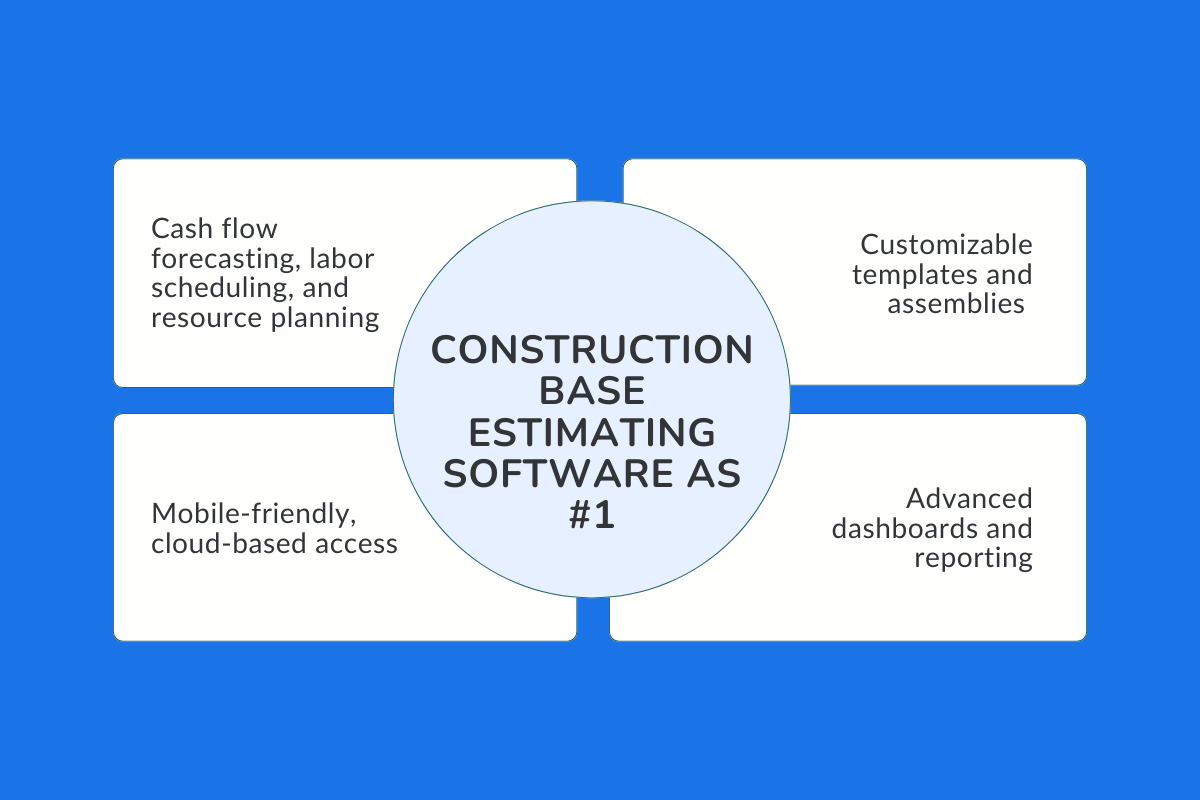
ConstructionBase is transforming how construction businesses approach estimating by combining automation, accuracy, and collaboration into a single, powerful platform.
At its core, the software performs automated material and labor takeoffs directly from digital plans, eliminating hours of manual data entry and reducing costly errors.
By integrating real-time supplier pricing, contractors can ensure every bid is competitive and up-to-date, reflecting current material and labor costs.
The platform goes beyond simple estimating. Key features include:
- Cash flow forecasting, labor scheduling, and resource planning to align budgets with project timelines.
- Customizable templates and assemblies for repeatable, consistent project estimates.
- Mobile-friendly, cloud-based access for seamless collaboration from the office or jobsite.
- Advanced dashboards and reporting that provide insights into cost trends, bid performance, and efficiency.
- Advanced dashboards and reporting that deliver insights into cost trends, bid performance, and operational efficiency.
- Document management for centralized storage of plans, change orders, and contracts in a secure system.
- Inventory management to monitor stock levels, automate reorders, and avoid material delays.
- Job costing and finance management tools that track expenses, support payroll, and streamline approvals.
- Automated quantity takeoffs from digital blueprints to quickly capture material and labor needs.
Whether you’re a small contractor or managing a large enterprise, ConstructionBase scales to fit your needs.
Its centralized document storage ensures that everyone works from the same data, reducing errors and improving team coordination.
With ConstructionBase, construction companies can produce error-free, professional proposals, accelerate bid submission, and make data-driven decisions that give them a clear edge in today’s competitive construction industry.
Conclusion
In the construction industry, where every minute and every rupee counts, construction estimating software is no longer optional; it’s essential. Tools like ConstructionBase redefine how contractors bid, blending speed, accuracy, and collaboration into one seamless experience.
With automation cutting bid prep time by up to 50–80%, teams can focus on strategy instead of spreadsheets.
The result? Clear estimates, confident bids, and consistent profits. For construction companies aiming to scale, innovate, and win more projects, the future of estimating is already here, and it’s digital.
About ConstructionBase
ConstructionBase empowers contractors to create accurate, data-driven estimates in minutes with automated takeoffs, real-time pricing, and advanced analytics. Its cloud-based platform streamlines collaboration, forecasting, and reporting, helping teams bid smarter and faster.
Schedule a demo today to see how ConstructionBase can transform your estimating process.
FAQs
1. Which is the best construction estimate software?
ConstructionBase is one of the best construction estimating software, offering automated takeoffs, real-time pricing, and cloud collaboration for accurate, efficient bids.
2. Can small contractors use construction estimating software?
Absolutely. Most modern tools, including ConstructionBase, are scalable for small to large firms. They simplify cost tracking, proposal creation, and collaboration—without needing a large tech setup or extra staff.
3. Which software is used for building estimation?
Popular options include ConstructionBase, PlanSwift, and STACK, which are used for detailed material, labor, and cost estimation across construction projects.
4. What integrations should I look for in estimating software?
Choose software that integrates with accounting platforms (like QuickBooks or Xero), project management tools, and CRM systems to create a seamless workflow from estimating to project completion.
Have questions or need personalized advice?
Talk to an Expert Today and let our construction specialists guide you to success.







